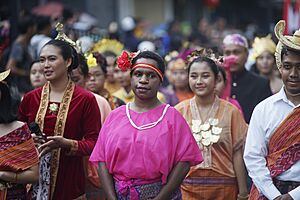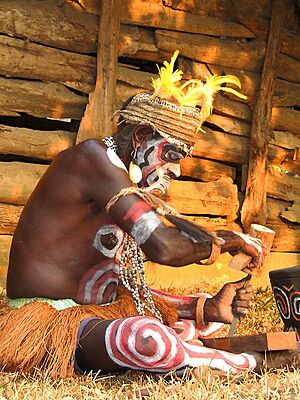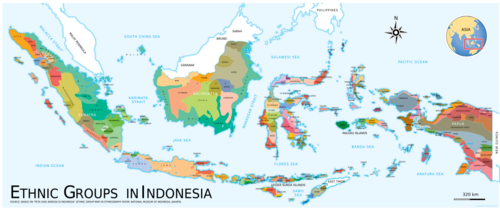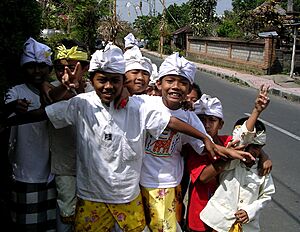Native Indonesians facts for kids

Indonesians wearing their indigenous costume during cultural carnaval
|
|
| Total population | |
|---|---|
| More than 300 million Including Indonesian ancestry c. 270 million Indonesia 2020 census c. 210 million Worldwide; 2006 estimate |
|
| Regions with significant populations | |
|
|
| Languages | |
| National Language Indonesian Regional Language Javanese, Sundanese, Malay, Madurese, Minangkabau, Betawi, Banjarese, Batak, Balinese, etc. |
|
| Religion | |
| Majority Islam (mostly Sunni, minority Shia, and Non-denominational) Minorities Christianity (Protestantism, Catholicism and Orthodoxy), Hinduism, Buddhism, Animism, Shamanism, Sunda Wiwitan, Kaharingan, Parmalim, Kejawen, Aluk To Dolo, Others. |
|
| Related ethnic groups | |
| Filipinos, Indonesians |
Native Indonesians, often called Pribumi or Bumiputra, are people in Indonesia whose families have lived in the Indonesian islands for many generations. This term helps tell them apart from Indonesians whose families originally came from other countries. These include groups like Chinese Indonesians, Arab Indonesians, Indian Indonesians, Japanese Indonesians, and Indo-Europeans (people with mixed Indonesian and European roots).
Contents
What Does "Pribumi" Mean?
The word pribumi became popular after Indonesia became independent. It was used instead of an older Dutch colonial word, inlander, which meant "native" but was seen as rude. The word pribumi comes from ancient Sanskrit words: pri (meaning "before") and bhumi (meaning "earth"). So, it means "first on the soil." Before Indonesia's independence, the word bumiputra was also used, meaning "son of the soil."
After Indonesia became its own country, pribumi was often used to tell apart native Indonesians from citizens whose families came from other places, especially Chinese Indonesians. People would often talk about pribumi and non-pribumi. Even though it sounds like "indigenous," the term pribumi has a wider meaning in Indonesia.
The Indonesian government, under President B. J. Habibie in 1998, said that the terms pribumi and non-pribumi should not be used. This was because these words could lead to unfair treatment based on a person's background.
How People Were Classified in the Past
The Dutch East India Company, which controlled parts of Indonesia starting in the 1600s, first sorted people mostly by their religion. Later, in 1815, the colonial government changed this system to classify people by their ethnic background.
At first, they separated people into "Europeans" (which included native Christians) and "Inlanders" (which included non-Christian Asians). Over time, native Indonesians were placed into the "Inlander" group. Other groups, like Chinese Indonesians and Arab Indonesians, were given a special status called "Foreign Orientals." This system was based on the father's background. For example, if a European man and an Indonesian woman married, their children were legally considered European.
Today, the main Indonesian dictionary defines pribumi as penghuni asli, which means "original, native, or indigenous inhabitant."
Who Are Native Indonesians?
Native Indonesians make up about 95% of the country's population. This means around 230 million people, based on 2006 numbers. The culture of these many different native groups plays a big part in how Indonesia's society and economy work.
The United States Library of Congress describes Pribumi as:
Literally, an indigene, or native. In the colonial era, the great majority of the population of the archipelago came to regard themselves as indigenous, in contrast to the non-indigenous Dutch and Chinese (and, to a degree, Arab) communities. After independence the distinction persisted, expressed as a dichotomy between elements that were pribumi and those that were not. The distinction has had significant implications for economic development policy
Indonesia is home to over 1,300 different ethnic groups. This makes it one of the most diverse countries in the world!
The largest ethnic group in Indonesia is the Javanese people. They make up about 41% of all Indonesians. Most Javanese live on the island of Java, but millions have moved to other islands. Other large groups include the Sundanese, Malay, Batak, and Madurese. Some ethnic groups, especially in Kalimantan and Papua, have only a few hundred members.
Most of the local languages in Indonesia belong to the Austronesian language family. However, many people, especially in places like North Maluku and West Papua, speak Papuan languages.
Sometimes, it can be tricky to classify ethnic groups in Indonesia. This is because people have moved around a lot, and cultures and languages have mixed. For example, some people think the Bantenese and Cirebonese are separate groups. Others see them as smaller parts of the larger Javanese people. The Betawi people are a clear example of a mixed group. They formed from different native groups blending with people of Arab, Chinese, and Indian origins over time in the city of Batavia (now Jakarta).
Here's a look at the largest Native Indonesian groups, based on the 2010 census:
| Ethnic groups | Population (million) | Percentage | Main regions |
|---|---|---|---|
| Javanese | 95.217 | 40.2 | Central Java, Yogyakarta, East Java, Lampung, Jakarta |
| Sundanese | 31.765 | 15.4 | West Java, Banten, Lampung |
| Malay | 8.789 | 4.1 | Sumatra eastern coast, West Kalimantan |
| Batak | 8.467 | 3.58 | North Sumatra |
| Madurese | 7 .179 | 3.03 | Madura island, East Java |
| Bugis | 6.000 | 2.9 | South Sulawesi, East Kalimantan |
| Minangkabau | 5.569 | 2.7 | West Sumatra, Riau |
| Betawi | 5.157 | 2.5 | Jakarta, Banten, West Java |
| Banjarese | 4.800 | 2.3 | South Kalimantan, East Kalimantan |
| Bantenese | 4.331 | 2.1 | Banten, West Java |
| Acehnese | 4.000 | 1.9 | Aceh |
| Balinese | 3.094 | 1.5 | Bali |
| Dayak | 3.009 | 1.5 | North Kalimantan, West Kalimantan, Central Kalimantan |
| Sasak | 3.000 | 1.4 | West Nusa Tenggara |
| Makassarese | 2.063 | 1.0 | South Sulawesi |
| Cirebonese | 1.856 | 0.9 | West Java, Central Java |
Smaller Ethnic Groups by Region

Indonesia has many smaller native ethnic groups in different regions. Because people move around a lot, sometimes for government programs, you can find these groups living outside their traditional areas too.
- Java: Javanese, Sundanese, Betawi, Bantenese, Tengger, Osing, Badui, and others.
- Madura: Madurese
- Sumatra: Batak, Minangkabau, Malays, Acehnese, Lampung, Kubu, and others
- Kalimantan: Dayak, Banjar, Kutai, and others.
- Sulawesi: Makassarese, Buginese, Mandar, Minahasa, Buton, Gorontalo, Toraja, Bajau, Mongondow, Buroko, Bolango, and others.
- Lesser Sunda Islands: Balinese, Sasak, Rotenese, Atoni, and others.
- Moluccas: Nuaulu, Manusela, Wemale, and others.
- Papua: Asmat, Amungme, Bauzi, Dani, Sawi, Yaur, and others (see List of ethnic groups of West Papua, Southwest Papua)
See also
- Culture of Indonesia
- Ethnic groups in Indonesia
- List of indigenous peoples
- List of Indonesian people
- National costume of Indonesia
- Overseas Indonesians
Non-Pribumi Indonesians
- African Indonesians
- Arab Indonesians
- Chinese Indonesians
- Dutch Indonesians
- Filipino Indonesians
- Indian Indonesians
- Jewish Indonesians
- Pakistani Indonesians
- Japanese Indonesians





